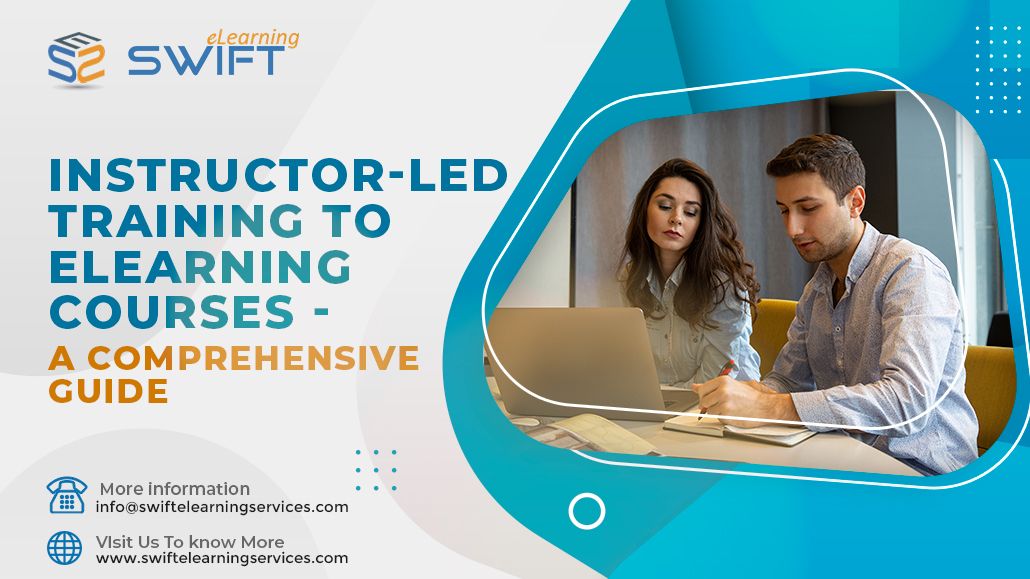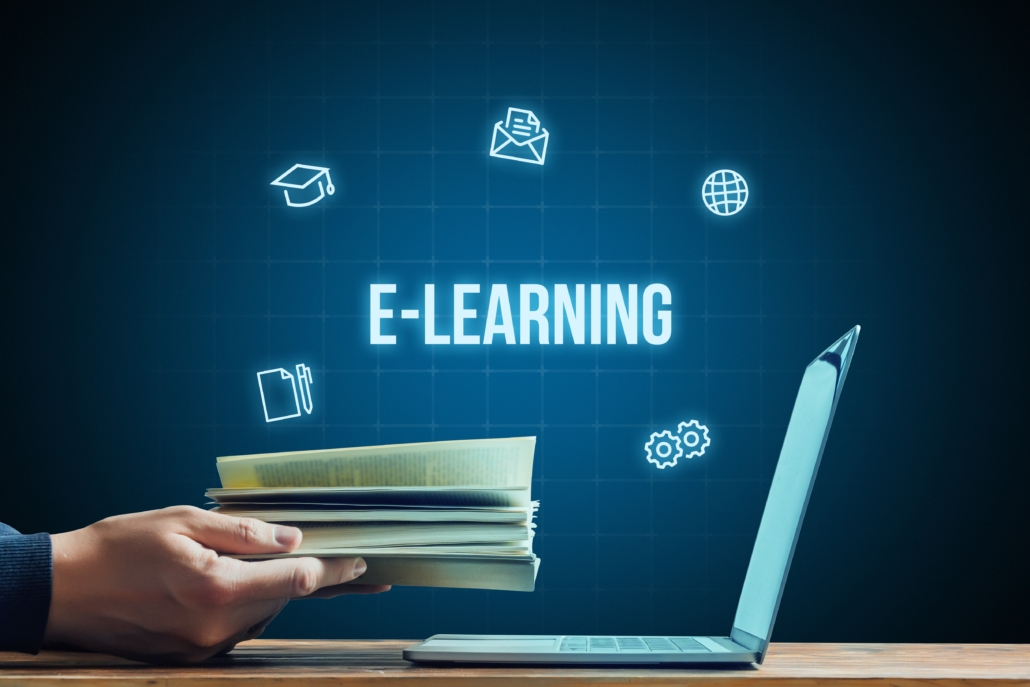Instructor-Led Training to eLearning Courses – A Comprehensive Guide
In the dynamic landscape of education and training, the digital revolution has ushered in a new era of learning through eLearning.
Converting traditional instructor-led training (ILT) programs into effective eLearning courses is a strategic move that harnesses the power of technology and flexibility to meet the diverse needs of learners.
This comprehensive guide explores the benefits and step-by-step process for successfully transforming ILT into engaging eLearning experiences. Before that, let’s first understand what instructor-led training and eLearning are.
1. Understanding Instructor-Led Training (ILT)
Instructor-Led Training (ILT), also known as classroom training or face-to-face training, refers to a traditional form of education where a qualified instructor or trainer delivers learning content to a group of learners in a physical setting.
In ILT, the instructor takes on the role of the primary facilitator, guiding learners through the curriculum, explaining concepts, answering questions, and fostering interactive discussions.
Key characteristics of Instructor-Led Training include:
1.1 Physical Presence
ILT involves learners and the instructor gathering in a specific physical location, such as a classroom, training centre, conference room, or workshop space. This face-to-face interaction allows for direct communication and immediate feedback.
1.2 Real-Time Interaction
Learners have the opportunity to interact with the instructor and their peers in real time. They can ask questions, engage in discussions, participate in group activities, and seek clarification on complex topics.
1.3 Structured Schedule
ILT sessions are typically scheduled at specific times and dates. Learners need to adhere to the predetermined schedule to attend the training sessions.
1.4 Personalized Guidance
Instructors can adapt their teaching methods to the needs of the learners in the room. They can gauge learners’ understanding through visual cues, adjust their pace, and provide additional explanations when necessary.
1.5 Hands-On Activities
Some ILT sessions involve practical exercises, hands-on activities, role-playing, and simulations that allow learners to apply theoretical concepts in a controlled environment.
1.6 Immediate Feedback
Learners receive instant feedback from the instructor and peers during discussions and activities. This feedback loop facilitates learning and comprehension.
1.7 Group Learning Dynamics
ILT often fosters group dynamics, allowing learners to learn from each other’s experiences and perspectives. Group discussions can lead to deeper understanding and collaboration.
1.8 Instructor’s Expertise
Instructors bring their subject matter expertise and experience to the training, providing learners with valuable insights, real-world examples, and practical tips.
1.9 Limited Reach and Scale
ILT can be limited by geographic constraints and the number of learners that can be accommodated in a physical space. This limitation can impact the scalability of training initiatives.
2. Understanding eLearning: Transforming Education in the Digital Age
ELearning, short for electronic learning, is a dynamic and innovative approach to education that leverages technology to deliver educational content and training through digital platforms. Unlike traditional classroom settings, eLearning enables learners to access course materials, engage in interactive activities, and participate in discussions online, breaking down geographical barriers and providing unprecedented flexibility. Let’s delve into the various aspects and advantages of eLearning.
Key Components of eLearning
2.1 Online Platforms
ELearning is facilitated through Learning Management Systems (LMS) or online platforms designed to host educational content. These platforms provide a structured framework for courses, containing modules, resources, assessments, and collaboration tools.
2.2 Digital Content
ELearning courses encompass a range of digital content, including text-based materials, videos, interactive quizzes, simulations, audio clips, infographics, and more. These multimedia elements enhance engagement and cater to diverse learning preferences.
2.3 Interactivity
Interactivity is a hallmark of eLearning. Learners actively engage with content through interactive activities, discussions, group projects, and simulations. This hands-on approach promotes deeper understanding and application of knowledge.
2.4 Self-Paced Learning
One of the defining features of eLearning is the ability for learners to progress at their own pace. Learners can access materials when convenient, enabling personalized learning journeys.
2.5 Assessment and Feedback
ELearning platforms offer various assessment methods, such as quizzes, assignments, and peer reviews. Immediate feedback helps learners gauge their progress and identify areas for improvement.
2.6 Flexibility
ELearning courses accommodate busy schedules and diverse lifestyles. Learners can access content from anywhere with an internet connection, allowing for learning on-the-go.
2.7 Scalability
ELearning courses can be easily scaled to accommodate a large number of learners without increasing resource demands significantly.
3. Benefits of Converting Instructor-Led Training to eLearning Courses
The shift from traditional instructor-led training (ILT) to eLearning courses has gained significant momentum in recent years. This transition offers a host of benefits that cater to the evolving preferences and demands of learners, while also providing organizations and educational institutions with enhanced flexibility and scalability. Let’s explore the key advantages of converting ILT to eLearning courses.
3.1 Accessibility and Flexibility
ELearning courses break down geographical barriers, allowing learners to access content from anywhere with an internet connection. This accessibility promotes learning for remote or geographically dispersed individuals, accommodating diverse schedules and time zones. Learners can access materials at their own pace, creating a flexible learning experience that suits their individual needs.
3.2 Cost-Effectiveness
Converting ILT to eLearning reduces costs associated with traditional training, such as travel, accommodation, venue rental, and printed materials. Once an eLearning course is developed, it can be reused and scaled for multiple cohorts of learners, minimizing ongoing expenses.
3.3 Scalability
ELearning courses can reach a larger audience without compromising quality. As organizations grow or expand, the eLearning platform can accommodate an increasing number of learners with minimal additional resources.
3.4 Personalized Learning
ELearning courses can be designed to offer personalized learning paths. Learners can choose modules based on their existing knowledge, interests, and learning goals. Adaptive learning technologies can analyse learner performance and provide tailored content recommendations.
3.5 Consistency of Content Delivery
Instructor-led training might result in inconsistencies in content delivery due to variations in presentation style or explanations.
ELearning ensures uniformity by delivering standardized content across all learners, leading to a more cohesive learning experience.
3.6 Enhanced Engagement
Interactive multimedia elements, simulations, quizzes, and gamification in eLearning courses boost learner engagement. The incorporation of these features facilitates active participation, leading to better retention and application of knowledge.
3.7 Real-Time Assessment and Feedback
ELearning allows for instantaneous assessments and feedback. Quizzes, assignments, and discussions can be automated to provide immediate results. Learners can track their progress, identify areas for improvement, and adjust their learning strategies accordingly.
3.8 Time Efficiency
ELearning eliminates the need for travel and commuting, saving learners valuable time. Additionally, learners can complete modules at their own pace, reducing the time required to master a topic.
3.9 Continuous Learning
ELearning courses support continuous learning and professional development. Learners can revisit modules to refresh their knowledge, staying up-to-date with industry trends and advancements.
3.10 Reduced Environmental Impact
The shift to eLearning contributes to environmental sustainability by reducing paper usage and minimizing the carbon footprint associated with physical training events.
3.11 Data-Driven Insights
ELearning platforms generate data on learner behaviour, engagement rates, and assessment performance. Educators and organizations can analyse this data to identify trends, areas of improvement, and opportunities for course enhancement.
3.12 Global Collaboration
Online discussion forums and collaborative tools enable learners from diverse backgrounds to interact, share ideas, and engage in meaningful discussions. This fosters a global perspective and enriches the learning experience.
4. Step by Step Guide – Instructor-Led Training to eLearning
Step 1: Needs Assessment and Goal Setting
Start by conducting a thorough needs assessment to understand the target audience, learning objectives, and desired outcomes. This analysis lays the foundation for the entire conversion process. Define clear goals for the eLearning course to ensure alignment with the organization’s or institution’s objectives.
Step 2: Content Adaptation and Structuring
Restructure ILT content to suit the online learning environment. Break down content into manageable modules or lessons, each focusing on a specific learning outcome. Consider the digital format and adapt content for multimedia integration, ensuring a seamless transition to eLearning.
Step 3: Interactive Content Development
Harness the power of multimedia to enhance engagement and comprehension. Incorporate videos, animations, infographics, and audio elements to present information visually and audibly. Develop interactive quizzes, simulations, and scenarios that encourage active participation and application of knowledge.
Step 4: Selection of eLearning Platform
Choose a suitable Learning Management System (LMS) that aligns with your course objectives. Look for features such as user-friendly interfaces, multimedia support, progress tracking, and assessment capabilities. The right platform streamlines the learning experience and supports both learners and instructors.
Step 5: Adapting Assessment Methods
Revamp assessment methods to fit the digital landscape. Replace traditional in-person evaluations with online quizzes, assignments, discussions, and peer reviews. Automate assessments to provide immediate feedback to learners and reduce administrative overhead.
Step 6: Fostering Engagement and Interactivity
Maintaining learner engagement is critical in eLearning. Incorporate collaborative elements such as discussion forums, chat rooms, and live webinars to facilitate peer interaction and real-time discussions. Implement gamification strategies like badges, points, and leaderboards to motivate learners.
Step 7: Redefining the Instructor Role
In the transition from ILT to eLearning, instructors evolve from presenters to facilitators. Their role shifts towards guiding and supporting learners in their individual journeys. Instructors should be accessible for questions, moderating discussions, and providing clarifications.
Step 8: Ensuring Accessibility and Inclusivity
Create an inclusive eLearning environment by adhering to accessibility standards. Utilize alt text for images, provide transcripts for multimedia, and choose clear fonts and color schemes. Opt for responsive design to ensure a seamless experience across various devices.
Step 9: Piloting and Feedback
Before launching the eLearning course widely, conduct a pilot test with a small group of learners. Gather feedback on content, navigation, and overall user experience. Incorporate valuable insights to enhance the course before its official launch.
Step 10: Continuous Improvement
ELearning courses are not static entities; they require continuous improvement. Regularly update course content based on evolving industry trends and learner feedback. Analyze metrics such as engagement rates and learner performance data to identify areas for enhancement.
5. Conclusion
Converting instructor-led training to eLearning courses represents a strategic move towards modernizing education and training. By conducting needs assessments, adapting content, fostering engagement, and leveraging technology, traditional training can be transformed into interactive, flexible, and learner-centered eLearning experiences. Embracing this transformation empowers educators and organizations to cater to the diverse learning needs of a digital-age audience, while also reaping the benefits of enhanced accessibility and scalability.
Frequently Asked Questions (FAQs)
What is the main difference between Instructor-Led Training (ILT) and eLearning courses?
ILT involves face-to-face training in a physical setting, where an instructor delivers content to learners.
ELearning courses, on the other hand, utilize digital platforms to deliver content online, allowing learners to access materials remotely.
Why should I consider converting ILT to eLearning courses?
Converting ILT to eLearning offers benefits such as increased accessibility, flexibility, cost-effectiveness, scalability, personalized learning paths, and the ability to track learner progress and engagement.
How do eLearning courses ensure learner engagement compared to ILT?
ELearning courses incorporate multimedia elements, interactive quizzes, simulations, discussions, and gamification, all of which enhance engagement and promote active participation.
What technology is required for eLearning courses?
You’ll need a Learning Management System (LMS) or an online platform to host your eLearning content. Learners will require devices like computers, tablets, or smartphones with internet access to access the materials.
Can I maintain the same level of interaction and feedback in eLearning courses as I do in ILT?
Yes, eLearning platforms offer various tools for interaction and feedback, such as discussion boards, live webinars, chat functions, and immediate assessment results.
How do eLearning courses handle assessments and evaluations?
ELearning courses use online quizzes, assignments, peer reviews, and discussions to assess learners’ understanding. Automated assessments provide immediate feedback.








